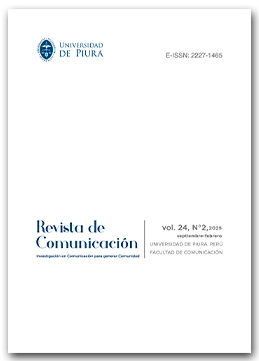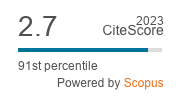La agradable sorpresa de los Easter eggs en el cine: análisis con eye-tracking y reconocimiento facial
DOI:
https://doi.org/10.26441/RC24.2-2025-3883Palabras clave:
neurociencia cognitiva, atención visual, reconocimiento facial, emociones, engagement, intertextualidad, cine de animación, narrativas audiovisuales, experiencia del espectador, marketing cinematográficoResumen
Propósito. Los Easter eggs son elementos ocultos que enriquecen la experiencia cinematográfica al generar sorpresa, curiosidad y conexión emocional. Esta investigación tiene como objetivo analizar el impacto atencional y emocional de los Easter eggs en el cine de animación mediante herramientas de neurocognición, valorando su potencial como recurso narrativo y de marketing. Metodología. Se diseñó un experimento intrasujeto con una muestra de 22 participantes entre 18 y 50 años. Se analizaron seis fotogramas de películas Disney y Pixar con Easter eggs de distinta complejidad e integración narrativa. Se utilizaron técnicas de eye-tracking, reconocimiento facial y cuestionarios para medir atención visual, emociones y engagement. Resultados y conclusiones. Los resultados muestran que los Easter eggs captan significativamente la atención, elevan el engagement y provocan emociones positivas como sorpresa y alegría. Su integración activa en la acción potencia su impacto. La complejidad del Easter egg influye en su reconocimiento y en la intensidad emocional, aunque el exceso puede dificultar su detección. Estos hallazgos refuerzan su valor como herramienta para intensificar la experiencia audiovisual y fidelizar a la audiencia. Aporte original. Este estudio ofrece evidencia empírica, mediante tecnologías neurocognitivas, del efecto positivo de los Easter eggs sobre la atención y las emociones del espectador. Se posiciona como un aporte novedoso para la creación de narrativas inmersivas en el ámbito audiovisual y para estrategias de comunicación y fidelización de marca basadas en la sorpresa y la implicación emocional.
Métricas
Citas
Abril Valdez, J. A. (2019). La afición por el cine ante la cultura digital: hacia una caracterización de la cinefilia 2.0. ZER: Revista de Estudios de Comunicación= Komunikazio Ikasketen Aldizkaria, 24(47). https://doi.org/10.1387/zer.20955 DOI: https://doi.org/10.1387/zer.20955
Albaladejo, S. (2019). El ecosistema mediático de la ficción contemporánea: relatos, universos y propiedades intelectuales a través de los transmedial worlds. Icono 14, 17(1). https://doi.org/10.7195/ri14.v17i1.1241 DOI: https://doi.org/10.7195/ri14.v17i1.1241
Atarama-Rojas, T. (2023). La audiencia social en la narrativa transmedia de Marvel. EUNSA, Ediciones Universidad de Navarra, SA.
Barr, P. (2020). Film adaptation as experimental game design. Arts, 9(4), 103 https://doi.org/10.3390/arts9040103 DOI: https://doi.org/10.3390/arts9040103
Barto, A., Mirolli, M., y Baldassarre, G. (2013). Novelty or surprise? Frontiers in psychology, 4, 907. https://doi.org/10.3389/fpsyg.2013.00907 DOI: https://doi.org/10.3389/fpsyg.2013.00907
Benedek, M., y Kaernbach, C. (2010). A continuous measure of phasic electrodermal activity. Journal of Neuroscience Methods, 190(1), 80-91. https://doi.org/10.1016/j.jneumeth.2010.04.028 DOI: https://doi.org/10.1016/j.jneumeth.2010.04.028
Berlyne, D. E. (1960). Conflict, Arousal, and Curiosity. McGraw Hill. DOI: https://doi.org/10.1037/11164-000
Botella, C., y García Celades, Y. (2019). La intertextualidad en Zootrópolis. ¿Cosa de niños? TRANS. Revista de Traductología, 23, pp. 169-182. https://doi.org/10.24310/TRANS.2019.v0i23.4927 DOI: https://doi.org/10.24310/TRANS.2019.v0i23.4927
Charpentier, C. J., Bromberg-Martin, E. S., y Sharot, T. (2018). Valuation of knowledge and ignorance in mesolimbic reward circuitry. Proceedings of the National Academy of Sciences, 115(31), E7255-E7264. https://doi.org/10.1073/pnas.1800547115 DOI: https://doi.org/10.1073/pnas.1800547115
Deci, E. L., y Ryan, R. M. (1985). The general causality orientations scale: Self-determination in personality. Journal of research in personality, 19(2), 109-134. https://doi.org/10.1016/0092-6566(85)90023-6 DOI: https://doi.org/10.1016/0092-6566(85)90023-6
Duffett, M. (2013). Understanding fandom: An introduction to the study of media fan culture. Bloomsbury Publishing USA. DOI: https://doi.org/10.5040/9781501388354
Ekman, P. (1992). An argument for basic emotions. Cognition y emotion, 6(3-4), 169-200. https://doi.org/10.1080/02699939208411068 DOI: https://doi.org/10.1080/02699939208411068
Ekman, P. (2007). The directed facial action task. Handbook of emotion elicitation and assessment, 47, 53. DOI: https://doi.org/10.1093/oso/9780195169157.003.0004
Evans, E. (2011). Transmedia television: Audiences, new media, and daily life. Routledge. https://doi.org/10.4324/9780203819104 DOI: https://doi.org/10.4324/9780203819104
Freire-Sánchez, A., Vidal-Mestre, M., y Fitó-Carreras, M. (2024). Proposed model for video game-to-series adaptation and intermedial translation based on the case of Fallout. Games and Culture, 15554120241299609. https://doi.org/10.1177/15554120241299609 DOI: https://doi.org/10.1177/15554120241299609
García-Avis, I., y Atarama-Rojas, T. (2025). Television Sitcoms through the Decades: Transmedia Intertextuality in Marvel’s WandaVision. Communication y Society. https://doi.org/10.15581/003.38.1.027 DOI: https://doi.org/10.15581/003.38.1.027
Garrido-Rodríguez, L., y Freire-Sánchez, A. (2024). Juegos de realidad alternativa (ARG) e implicación del fandom en el universo narrativo de Taylor Swift. Obra digital, (25), 25-40. https://doi.org/10.25029/od.2024.404.25 DOI: https://doi.org/10.25029/od.2024.404.25
Hidi, S. (2000). An interest researcher's perspective: The effects of extrinsic and intrinsic factors on motivation. In Intrinsic and extrinsic motivation (pp. 309-339). Academic Press. https://doi.org/10.1016/B978-012619070-0/50033-7 DOI: https://doi.org/10.1016/B978-012619070-0/50033-7
Kamienkowski, J. E., Ison, M. J., Quiroga, R. Q., y Sigman, M. (2012). Fixation-related potentials in visual search: A combined EEG and eye-tracking study. Journal of vision, 12(7), 4-4. DOI: https://doi.org/10.1167/12.7.4
Karandikar, S., Kapoor, H., y Litman, J. (2021). Why so curious? Validation and cross‐cultural investigation of the Hindi Epistemic Curiosity Scale. Asian Journal of Social Psychology, 24(1), 69-82. https://doi.org/10.1111/ajsp.12425 DOI: https://doi.org/10.1111/ajsp.12425
Kensinger, E. A., y Schacter, D. L. (2008). Memory and emotion. Handbook of emotions, 3, 601-617.
Kringelbach, M. L., y Berridge, K. C. (2009). Towards a functional neuroanatomy of pleasure and happiness. Trends in cognitive sciences, 13(11), 479-487. DOI: https://doi.org/10.1016/j.tics.2009.08.006
Kristeva, J (1969). Semiotiké. Recherches pour une sémanalyse. Seuil.
Kristeva, J (1984). El texto de la novela. Lumen
Kumbara, A. N. A., Dewi, A. S. K., Liando, M. R., y Wiasti, M. (2020). Cultural disruption and challenges for anthropology in the development of multicultural communities. ETNOSIA: Jurnal Etnografi Indonesia, 5(1), 5-14. https://doi.org/10.31947/etnosia.v5i1.8679 DOI: https://doi.org/10.31947/etnosia.v5i1.8679
Kusuma, A., Purbantina, A. P., Nahdiyah, V., y Khasanah, U. U. (2020). A virtual ethnography study: Fandom and social impact in digital era. ETNOSIA: Jurnal Etnografi Indonesia, 5(2), 238-251. https://doi.org/10.31947/etnosia.v5i2.10898 DOI: https://doi.org/10.31947/etnosia.v5i2.10898
Lakier, M., y Vogel, D. (2022). More than just software surprises: purposes, processes, and directions for software application Easter eggs. Proceedings of the ACM on Human-Computer Interaction, 6(CSCW1), 1-26. https://doi.org/10.1145/3512949 DOI: https://doi.org/10.1145/3512949
Martínez-Martínez, L. (2021). Casos exploratorios aplicados a partir de distintos diseños metodológicos: eye-tracking fijo y online. Comunicación y métodos, 3(2), 125-141. https://doi.org/10.35951/v3i2.136 DOI: https://doi.org/10.35951/v3i2.136
Martínez-Martínez, L., Cuesta, U. y Niño, J.I. (2021). Comunicación sobre vacunas e imágenes bottom-up. Seduciendo al usuario. Fragua.
Menges, R., Kramer, S., Hill, S., Nisslmueller, M., Kumar, C., y Staab, S. (2020, June). A visualization tool for eye-tracking data analysis in the web. In ACM Symposium on Eye-tracking Research and Applications (pp. 1-5). https://doi.org/10.1145/3379156.3391831 DOI: https://doi.org/10.1145/3379156.3391831
Mittell, J. (2015). Complex TV: The poetics of contemporary television storytelling. nyu Press.
Montfort, N. (2009). Racing the Beam: The Atari Video Computer System. MIT Press. DOI: https://doi.org/10.7551/mitpress/7588.001.0001
Nakamura, J., y Csikszentmihalyi, M. (2020). 20 The Experience of Flow. The Oxford handbook of positive psychology, 279. DOI: https://doi.org/10.1093/oxfordhb/9780199396511.013.16
Real Academia Española (2001). Cultura. Em Diccionario de la lengua española. Recuperado en 30 de octubre de 2024, de https://www.rae.es/drae2001/fan#:~:text=1.%20com.,Entusiasta%20de%20algo.
Reichardt, R., Polner, B., y Simor, P. (2020). Novelty manipulations, memory performance, and predictive coding: The role of unexpectedness. Frontiers in human neuroscience, 14, 152. https://doi.org/10.3389/fnhum.2020.00152 DOI: https://doi.org/10.3389/fnhum.2020.00152
Reisenzein, R., Horstmann, G., y Schützwohl, A. (2019). The cognitive-evolutionary model of surprise: a review of the evidence. Topics in Cognitive Science, 11(1), 50–74. https://doi.org/10.1111/tops.12292 DOI: https://doi.org/10.1111/tops.12292
Scolari, C. (2013). Narrativas transmedia: cuando todos los medios cuentan. https://bit.ly/43mwNVP
Tajfel, H., Turner, J. C., Austin, W. G., y Worchel, S. (1979). An integrative theory of intergroup conflict. Organizational identity: A reader, 56(65), 9780203505984-16. DOI: https://doi.org/10.1093/oso/9780199269464.003.0005
Taylor, J. C. (2021). Reading the Marvel Cinematic Universe: The Avengers' Intertextual Aesthetic. JCMS: Journal of Cinema and Media Studies, 60(3), 129-156. https://doi.org/10.1353/cj.2021.0030 DOI: https://doi.org/10.1353/cj.2021.0030
Tulving, E. (2002). Episodic memory: From mind to brain. Annual review of psychology, 53(1), 1-25. https://doi.org/10.1146/annurev.psych.53.100901.135114 DOI: https://doi.org/10.1146/annurev.psych.53.100901.135114
Turner, J.C. (1982). Towards a cognitive redefinition of the social group. En H. Tajfel (Ed.): Social identity and intergroup relations. Cambridge University Press.
Turner, A. (2017). Convergence Culture: Where old and new media collide. Revista Austral De Ciencias Sociales, (20), 129–134. https://doi.org/10.4206/rev.austral.cienc.soc.2011.n20-09 DOI: https://doi.org/10.4206/rev.austral.cienc.soc.2011.n20-09
Vortmann, L. M., Ceh, S., y Putze, F. (2022). Multimodal eeg and eye-tracking feature fusion approaches for attention classification in hybrid bcis. Frontiers in Computer Science, 4, 780580. https://doi.org/10.3389/fcomp.2022.780580 DOI: https://doi.org/10.3389/fcomp.2022.780580
Wedel, M., y Pieters, R. (2000). Eye fixations on advertisements and memory for brands: A model and findings. Marketing science, 19(4), 297-312. https://doi.org/10.1287/mksc.19.4.297.11794 DOI: https://doi.org/10.1287/mksc.19.4.297.11794
Wedel, M., Pieters, R., y van der Lans, R. (2023). Modeling eye movements during decision making: A review. Psychometrika, 88(2), 697-729. https://link.springer.com/article/10.1007/s11336-022-09876-4 DOI: https://doi.org/10.1007/s11336-022-09876-4
Zhu, L., y Lv, J. (2023). Review of studies on user research based on EEG and eye-tracking. Applied Sciences, 13(11), 6502. https://doi.org/10.3390/app13116502 DOI: https://doi.org/10.3390/app13116502
Publicado
Cómo citar
Número
Sección
Licencia
Derechos de autor 2025 Revista de Comunicación

Esta obra está bajo una licencia internacional Creative Commons Atribución-NoComercial-SinDerivadas 4.0.











 Portal de Revistas de la Universidad de Piura.
Portal de Revistas de la Universidad de Piura.